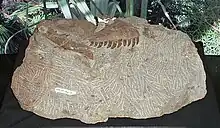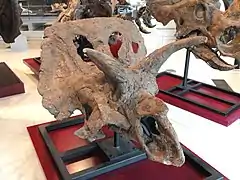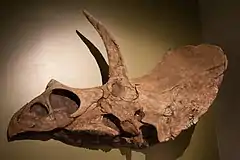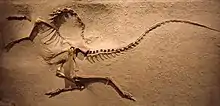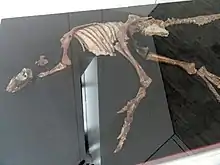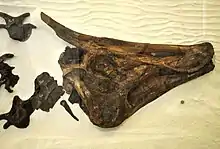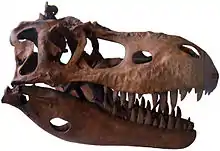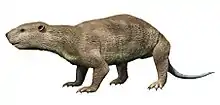Horseshoe Canyon Formation
The Horseshoe Canyon Formation is a stratigraphic unit of the Western Canada Sedimentary Basin in southwestern Alberta.[2][3] It takes its name from Horseshoe Canyon, an area of badlands near Drumheller.
| Horseshoe Canyon Formation | |
|---|---|
| Stratigraphic range: Campanian-Maastrichtian ~[1] | |
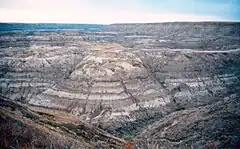 Horseshoe Canyon Formation at Horsethief Canyon, near Drumheller. The dark bands are coal seams. | |
| Type | Geological formation |
| Unit of | Edmonton Group |
| Sub-units | Strathmore Member, Drumheller Member, Horsethief Member, Morrin Member, Tolman Member, Carbon Member, Whitemud Member |
| Underlies | Battle Formation, Scollard Formation |
| Overlies | Bearpaw Formation |
| Lithology | |
| Primary | Sandstone |
| Other | Shale, coal |
| Location | |
| Coordinates | 51°25′24″N 112°53′18″W |
| Region | Western Canadian Sedimentary Basin |
| Country | |
| Type section | |
| Named for | Horseshoe Canyon |
| Named by | E.J.W. Irish, 1970 |
The Horseshoe Canyon Formation is part of the Edmonton Group. In its type section (Red Deer River Valley at Drumheller), it is ~250 metres (820 ft) thick, but further west the formation is older and thicker, exceeding 500 metres (1,600 ft) near Calgary.[4] It is of Late Cretaceous age, Campanian to early Maastrichtian stage (Edmontonian Land-Mammal Age), and is composed of mudstone, sandstone, carbonaceous shales, and coal seams. A variety of depositional environments are represented in the succession, including floodplains, estuarine channels, and coal swamps, which have yielded a diversity of fossil material. Tidally-influenced estuarine point bar deposits are easily recognizable as Inclined Heterolithic Stratification (IHS). Brackish-water trace fossil assemblages occur within these bar deposits and demonstrate periodic incursion of marine waters into the estuaries.
The Horseshoe Canyon Formation crops out extensively in the area around Drumheller, as well as farther north along the Red Deer River near Trochu and along the North Saskatchewan River in Edmonton.[2] It is overlain by the Battle and Scollard formations.[4] The Drumheller Coal Zone, located in the lower part of the Horseshoe Canyon Formation, was mined for sub-bituminous coal in the Drumheller area from 1911 to 1979, and the Atlas Coal Mine in Drumheller has been preserved as a National Historic Site.[5] In more recent times, the Horseshoe Canyon Formation has become a major target for coalbed methane (CBM) production.
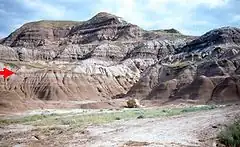
Dinosaurs found in the Horseshoe Canyon Formation include Albertavenator, Albertosaurus, Anchiceratops, Anodontosaurus, Arrhinoceratops, Atrociraptor, Epichirostenotes, Edmontonia, Edmontosaurus, Hypacrosaurus, Ornithomimus, Pachyrhinosaurus, Parksosaurus, Saurolophus, and Struthiomimus. Other finds have included mammals such as Didelphodon coyi, non-dinosaur reptiles, amphibians, fish, marine and terrestrial invertebrates and plant fossils. Reptiles such as turtles and crocodilians are rare in the Horseshoe Canyon Formation, and this was thought to reflect the relatively cool climate which prevailed at the time. A study by Quinney et al. (2013) however, showed that the decline in turtle diversity, which was previously attributed to climate, coincided instead with changes in soil drainage conditions, and was limited by aridity, landscape instability, and migratory barriers.[6]
Oil/gas production
The Drumheller Coal Zone has been a primary coalbed methane target for industry. In the area between Bashaw and Rockyford, the Coal Zone lies at relatively shallow depths (about 300 metres) and is about 70 to 120 metres thick. It contains 10 to 20 metres of cumulative coal, in up to 20 or more individual thin seams interbedded with sandstone and shale, which combine to make an attractive multi-completion CBM drilling target. In total, it is estimated there are 14 trillion cubic metres (500 tcf) of gas in place in all the coal in Alberta.
Biostratigraphy
The timeline below follows work by David A. Eberth and Sandra L. Kamo published in 2019.[7]

Dinosaurs
Ankylosaurs
| Ankylosaurs reported from the Horseshoe Canyon Formation | ||||||
|---|---|---|---|---|---|---|
| Genus | Species | Stratigraphic position | Material | Notes | Images | |
| [Five] skulls, mandibles, cervical vertebra, caudal vertebrae, dorsal vertebrae, sacrocaudal vertebrae, sacrum, illium, ischium, partial pelvis, coossified ribs, femur, ?manual phalanx, tail clubs, numerous cervical half-rings and osteoderms.[8][9] |
An ankylosaurine ankylosaurid also known from the middle Dinosaur Park Formation and closely related to Ankylosaurus.[10] |
| ||||
|
E. longiceps[11] |
Upper Horsethief[11] |
A skull with mandible, dorsal vertebrae, dorsal vertebrae, sacral vertebrae, caudal vertebrae, cervical ribs, dorsal ribs, humerus, radius, ulna, radius, ilia, ischia, both pubes (?), femur, tibia, fibula and osteoderms.[11] |
A panoplosaurin nodosaurid also known from the lower Dinosaur Park Formation and closely related Denversaurus.[12] | |||
|
E. tutus |
Walter Coombs (1971) synonymised Anodontosaurus lambei with E. tutus. However, recent studies suggest that Anodontosaurus is distinct enough from Euoplocephalus to be placed in its own genus and species.[8][13] Furthermore, all Horseshoe Canyon Formation ankylosaurine specimens were suggested to be reassigned to Anodontosaurus.[9] | |||||
Maniraptorans
| Maniraptors reported from the Horseshoe Canyon Formation | ||||||
|---|---|---|---|---|---|---|
| Genus | Species | Stratigraphic position | Material | Notes | Images | |
|
A. curriei[14] |
Horsethief[14] |
[Two] frontals.[14] |
A troodontid theropod that adds to the diversity of North American troodontids.[14] |
| ||
|
A. borealis[15] |
Upper Tolman[15] |
Ulna, tibiae, metatarsals, manual ungual, pedal phalanxes and unidentified pedal phalanges.[15] |
An mononykin alvarezsaurid specialized for digging insect nests.[15] | |||
|
A. pennatus[16] |
Horsethief[16] |
A palatine, mandibles, ceratobranchials, axis, cervical vertebrae, dorsal vertebrae, pectoral girdles, sternal plate, forelimb, ilium, femur, tibia and fibula.[16] |
A caenagnathid oviraptorosaur recovered as sister taxon to Elmisaurus .[16] | |||
|
A. marshalli[17] |
Lower Horsethief[17] |
Premaxillae, maxilla, dentaries, teeth and numerous bone fragments.[17] |
A dromaeosaurid; teeth indicate it may have been present across all members.[17] | |||
|
E. curriei[18] |
Horsethief, Morrin, and Tolman[18] |
A maxilla, probable palatine, partial braincase, cervical vertebrae, dorsal vertebrae, caudal vertebrae, synsacrum, an anterior and a posterior cervical rib, a mid-dorsal rib, fragments of ilia, ischium, both pubes, partial tibia, and unidentifiable bones.[18] |
A caenagnathid oviraptorosaur known from material previously assigned to Chirostenotes.[18] | |||
Marginocephalians
Color key
|
Notes Uncertain or tentative taxa are in small text; |
| Marginocephalians reported from the Horseshoe Canyon Formation | ||||||
|---|---|---|---|---|---|---|
| Genus | Species | Stratigraphic position | Material | Notes | Images | |
|
Horsethief, Morrin, and Tolman; may have been present in Drumheller[20] |
[Two] nearly complete skulls and [seven] partial skulls.[20] |
A chasmosaurine ceratopsid contemporaneous and closely related to Arrhinoceratops.[20] |
| |||
|
A. brachyops[21] |
Horsethief[21] |
A nearly complete skull.[21] |
A chasmosaurine ceratopsid restricted to the holotype specimen as Farke (2007) assigned the referred specimen ROM 1439 to Torosaurus.[22] | |||
|
E. xerinsularis[23] |
Carbon[23] |
Premaxillae, maxillae, rostral, supraorbital horncore with lacrimal, prefrontal, frontal, postorbital, jugal, epijugal, quadratojugal, quadrate, partial parietal, squamosal frill, braincase, syncervical, cervical vertebrae, dorsal vertebrae, ribs and fragments of ossified ligaments.[23] |
A large chasmosaurine ceratopsid that may represent a senior synonym of Ojoceratops from the Ojo Alamo Formation.[24] | |||
|
Upper Tolman[26] |
An isolated braincase.[26] |
A leptoceratopsid ceratopsian also known from the St. Mary River Formation.[25] | ||||
|
P. canadensis[27] |
Drumheller and Horsethief[27] |
[Two] partial skulls.[27] |
A centrosaurine ceratopsid also known from the St. Mary River Formation.[27] | |||
|
S. edmontonense[29] |
Tolman[28] |
A pachycephalosaurine pachycephalosaurid also known from the Hell Creek and Kirtland Formation.[29] | ||||
Ornithomimids
Color key
|
Notes Uncertain or tentative taxa are in small text; |
| Ornithomimids reported from the Horseshoe Canyon Formation | ||||||
|---|---|---|---|---|---|---|
| Genus | Species | Location | Stratigraphic position | Material | Notes | Images |
|
O. currelli |
Junior synonym of O. edmontonicus |
| ||||
|
O. edmontonicus |
Drumheller, Horsethief, Morrin, and Tolman |
Several specimens, type specimen |
An ornithomimid | |||
|
S. altus |
Drumheller, Horsethief, and Morrin |
An ornithomimid | ||||
Hadrosaurs and thescelosaurs
| Hadrosaurs and thescelosaurids reported from the Horseshoe Canyon Formation | ||||||
|---|---|---|---|---|---|---|
| Genus | Species | Location | Stratigraphic position | Material | Notes | Images |
|
Horsethief; likely present in Drumheller. |
| |||||
|
H. altispinus |
Morrin and Tolman. |
"[Five to ten] articulated skulls, some associated with postcrania, isolated skull elements, isolated postcranial elements, many individuals, embryo to adult."[30] |
||||
|
P. warreni |
Tolman |
|||||
|
S. osborni |
Upper Morrin and Tolman. |
"Complete skull and skeleton, [two] complete skulls."[30] |
||||
Tyrannosaurs
Color key
|
Notes Uncertain or tentative taxa are in small text; |
| Theropods reported from the Horseshoe Canyon Formation | ||||||
|---|---|---|---|---|---|---|
| Genus | Species | Location | Stratigraphic position | Material | Notes | Images |
|
A. arctunguis |
Junior synonym of A. sarcophagus |
| ||||
|
A. sarcophagus |
Horsethief, Morrin, and Tolman; likely present in Drumheller and Carbon. |
Several skeletons and partial skeletons, type specimen |
A tyrannosaurid which was the most common large carnivore in the area.[31][32] | |||
|
D. sp. |
Suggested from the skeleton of an immature tyrannosaurid (CMN 11315), thorough analysis of this specimen supports a referral to A. sarcophagus.[33] An isolated maxilla and teeth from an Edmontosaurus bonebed were also mistakenly referred to Daspletosaurus, however all the tyrannosaurid material in the bonebed was confirmed to belong to A. sarcophagus.[34] | |||||
Other Animals
Mammals
Color key
|
Notes Uncertain or tentative taxa are in small text; |
| Mammals reported from the Horseshoe Canyon Formation | ||||||
|---|---|---|---|---|---|---|
| Genus | Species | Location | Stratigraphic position | Material | Notes | Images |
|
D. coyi |
||||||
Other Reptiles
Color key
|
Notes Uncertain or tentative taxa are in small text; |
| Reptiles reported from the Horseshoe Canyon Formation | ||||||
|---|---|---|---|---|---|---|
| Genus | Species | Location | Stratigraphic position | Material | Notes | Images |
|
S. mccabei |
"a skull, partial lower jaws, and partial postcranial skeleton" |
An alligatoroid |
||||
|
C. albertensis |
"partial skeleton with partial skull" |
|||||
|
L. ultimus |
"a partial skeleton" |
a plesiosaur of uncertain classification |
||||
|
B. morrinensis |
"nearly complete shell" |
|||||
Fish
Color key
|
Notes Uncertain or tentative taxa are in small text; |
| Fish reported from the Horseshoe Canyon Formation | ||||||
|---|---|---|---|---|---|---|
| Genus | Species | Location | Stratigraphic position | Material | Notes | Images |
| Boreiosturion[40] | B. labyrinthicus | Edmonton. | Partial skull. | A sturgeon. | ||
|
Horseshoeichthys[41] |
H. armaserratus |
An ellimmichthyiform |
||||
References
- Eberth, David A.; Kamo, Sandra L. (October 2020). "High-precision U–Pb CA–ID–TIMS dating and chronostratigraphy of the dinosaur-rich Horseshoe Canyon Formation (Upper Cretaceous, Campanian–Maastrichtian), Red Deer River valley, Alberta, Canada". Canadian Journal of Earth Sciences. 57 (10): 1220–1237. doi:10.1139/cjes-2019-0019. ISSN 0008-4077.
- Prior, G. J., Hathaway, B., Glombick, P.M., Pana, D.I., Banks, C.J., Hay, D.C., Schneider, C.L., Grobe, M., Elgr, R., and Weiss, J.A. (2013). "Bedrock Geology of Alberta. Alberta Geological Survey, Map 600". Archived from the original on 2013-07-05. Retrieved 2013-08-13.
{{cite web}}: CS1 maint: multiple names: authors list (link) - Mossop, G.D. and Shetsen, I., (compilers), Canadian Society of Petroleum Geologists (1994). "The Geological Atlas of the Western Canada Sedimentary Basin, Chapter 24: Upper Cretaceous and Tertiary strata of the Western Canada Sedimentary Basin". Archived from the original on 2013-07-21. Retrieved 2013-08-01.
{{cite web}}: CS1 maint: multiple names: authors list (link) - Eberth, David A.; Braman, Dennis R. (September 2012). "A revised stratigraphy and depositional history for the Horseshoe Canyon Formation (Upper Cretaceous), southern Alberta plains". Canadian Journal of Earth Sciences. 49 (9): 1053–1086. doi:10.1139/e2012-035. ISSN 0008-4077.
- "Mine History". Atlas Coal Mine National Historic Site. Archived from the original on 23 August 2010. Retrieved 9 June 2010.
- Quinney, Annie; Therrien, François; Zelenitsky, Darla K.; Eberth, David A. (2013). "Palaeoenvironmental and palaeoclimatic reconstruction of the Upper Cretaceous (late Campanian–early Maastrichtian) Horseshoe Canyon Formation, Alberta, Canada". Palaeogeography, Palaeoclimatology, Palaeoecology. 371: 26–44. Bibcode:2013PPP...371...26Q. doi:10.1016/j.palaeo.2012.12.009.
- Eberth, David A.; Kamo, Sandra (2019). "High-precision U-Pb CA-ID-TIMS dating and chronostratigraphy of the dinosaur-rich Horseshoe Canyon Formation (Upper Cretaceous, Campanian–Maastrichtian), Red Deer River valley, Alberta, Canada". Canadian Journal of Earth Sciences. 57 (10): 1220–1237. doi:10.1139/cjes-2019-0019. S2CID 210299227.
- Penkalski, P. (2013). "A new ankylosaurid from the late Cretaceous Two Medicine Formation of Montana, USA". Acta Palaeontologica Polonica. doi:10.4202/app.2012.0125.
- Arbour, Victoria (2010). "A Cretaceous armoury: Multiple ankylosaurid taxa in the Late Cretaceous of Alberta, Canada and Montana, USA". Journal of Vertebrate Paleontology. 30 (Supplement 2): 55A. doi:10.1080/02724634.2010.10411819.
- Paul Penkalski (2018). Revised systematics of the armoured dinosaur Euoplocephalus and its allies. Neues Jahrbuch für Geologie und Paläontologie - Abhandlungen 287(3): 261-306. doi: https://doi.org/10.1127/njgpa/2018/0717
- Sternberg, C.M. (1928). "A new armored dinosaur from the Edmonton Formation of Alberta". Transactions of the Royal Society of Canada. Series 3. 22: 93–106.
- Russell, L.S. (1940). "Edmontonia rugosidens (Gilmore), an armored dinosaur from the Belly River Series of Alberta". University of Toronto Studies, Geology Series. 43: 3–28.
- Penkalski, P.; Blows, W. T. (2013). "Scolosaurus cutleri (Ornithischia: Ankylosauria) from the Upper Cretaceous Dinosaur Park Formation of Alberta, Canada". Canadian Journal of Earth Sciences. 50 (2): 171–182. Bibcode:2013CaJES..50..171P. doi:10.1139/cjes-2012-0098.
- Evans, D.C., Cullen, T.M., Larson, D.W., and Rego, A. "A new species of troodontid theropod (Dinosauria: Maniraptora) from the Horseshoe Canyon Formation (Maastrichtian) of Alberta, Canada." Canadian Journal of Earth Sciences Early Online: 813-826. DOI: dx.doi.org/10.1139/cjes-2017-0034
- Longrich, Nicholas R.; Currie, Philip J. (2009). "Albertonykus borealis, a new alvarezsaur (Dinosauria: Theropoda) from the Early Maastrichtian of Alberta, Canada: Implications for the systematics and ecology of the Alvarezsauridae". Cretaceous Research. 30 (1): 239–252. Bibcode:2009CrRes..30..239L. doi:10.1016/j.cretres.2008.07.005.
- Gregory F. Funston; Philip J. Currie (2016). "A new caenagnathid (Dinosauria: Oviraptorosauria) from the Horseshoe Canyon Formation of Alberta, Canada, and a reevaluation of the relationships of Caenagnathidae". Journal of Vertebrate Paleontology. 36 (4): e1160910. Bibcode:2016JVPal..36E0910F. doi:10.1080/02724634.2016.1160910. S2CID 131090028.
- Currie, P. J. and D. J. Varricchio (2004). "A new dromaeosaurid from the Horseshoe Canyon Formation (Upper Cretaceous) of Alberta, Canada". Pp. 112–132 in P. J. Currie, E. B. Koppelhus, M. A. Shugar and J. L. Wright. (eds.), Feathered Dragons. Indianapolis: Indiana University Press.
- Robert M. Sullivan; Steven E. Jasinski; Mark P.A. Van Tomme (2011). "A new caenagnathid Ojoraptorsaurus boerei, n. gen., n. sp. (Dinosauria, Oviraptorosauria), from the Upper Ojo Alamo Formation (Naashoibito Member), San Juan Basin, New Mexico" (PDF). Fossil Record 3. New Mexico Museum of Natural History and Science Bulletin. 53: 418–428.
- Brown, B (1914). "Anchiceratops, a new genus of horned dinosaurs from the Edmonton Cretaceous of Alberta. With a discussion of the origin of the ceratopsian crest and the brain casts of Anchiceratops and Trachodon"". Bulletin of the American Museum of Natural History. 33: 539–548.
- Mallon, Jordan C.; Holmes, Robert; Eberth, David A.; Ryan, Michael J.; Anderson, Jason S. (2012). "Variation in the skull of Anchiceratops (Dinosauria, Ceratopsidae) from the Horseshoe Canyon Formation (Upper Cretaceous) of Alberta". Journal of Vertebrate Paleontology. 31 (5): 1047–1071. doi:10.1080/02724634.2011.601484. S2CID 86349131.
- Parks, W.A. (1925). "Arrhinoceratops brachyops, a new genus and species of Ceratopsia from the Edmonton Formation of Alberta". University of Toronto Studies, Geology Series 19:1-15
- Farke, A.A., 2007, "Cranial osteology and phylogenetic relationships of the chasmosaurine ceratopsid Torosaurus latus", pp 235-257 in: K. Carpenter (ed.), Horns and Beaks: Ceratopsian and Ornithopod Dinosaurs, Bloomington, Indiana University Press
- Wu, X-C.; Brinkman, D.B.; Eberth, D.A.; Braman, D.R. (2007). "A new ceratopsid dinosaur (Ornithischia) from the uppermost Horseshoe Canyon Formation (upper Maastrichtian), Alberta, Canada". Canadian Journal of Earth Sciences. 44 (9): 1243–1265. Bibcode:2007CaJES..44.1243W. doi:10.1139/E07-011.
- Wick, S. L.; Lehman, T. M. (2013). "A new ceratopsian dinosaur from the Javelina Formation (Maastrichtian) of West Texas and implications for chasmosaurine phylogeny". Naturwissenschaften. 100 (7): 667–82. Bibcode:2013NW....100..667W. doi:10.1007/s00114-013-1063-0. PMID 23728202. S2CID 16048008.
- Brown, B.; Schlaikjer, E. M. (1942). "The skeleton of Leptoceratops with the description of a new species". American Museum Novitates (1169): 1–15.
- P. J. Makovicky. 2001. A Montanoceratops cerorhynchus (Dinosauria: Ceratopsia) braincase from the Horseshoe Canyon Formation of Alberta. Mesozoic Vertebrate Life, D. H. Tanke and K. Carpenter (eds.), Indiana University Press, Bloomington 243-262
- Sternberg, C. M. (1950). "Pachyrhinosaurus canadensis, representing a new family of the Ceratopsia, from southern Alberta". National Museum of Canada Bulletin. 118: 109–120.
- Longrich N. R.; Sankey J. T.; et al. (2010). "Texacephale langstoni, a new genus of pachycephalosaurid (Dinosauria: Ornithischia) from the upper Campanian Aguja Formation, southern Texas, USA". Cretaceous Research. 31 (2): 274–284. Bibcode:2010CrRes..31..274L. doi:10.1016/j.cretres.2009.12.002.
- Williamson Thomas E.; Carr Thomas D. (2002). "A new genus of highly derived pachycephalosaurian from western North America". Journal of Vertebrate Paleontology. 22 (4): 779–801. doi:10.1671/0272-4634(2002)022[0779:angodp]2.0.co;2. S2CID 86112901.
- "Table 20.1," in Weishampel, et al. (2004). Page 441.
- Coulton, Richard L. (1977). "The Theropod Dinosaurs of the Edmonton Formation, Alberta, Canada". Rocks & Minerals. 52 (4): 176–181. doi:10.1080/00357529.1977.11761949. Retrieved 21 March 2021.
- Tanke, Darren H.; Currie, Phillip J. (7 September 2010). "A history of Albertosaurus discoveries in Alberta, Canada". Canadian Journal of Earth Sciences. 47 (9): 1197–1211. Bibcode:2010CaJES..47.1197T. doi:10.1139/e10-057. Retrieved 21 March 2021.
- Mallon, J.C.; Bura, J.R.; Currie, P.J. (2019). "A Problematic Tyrannosaurid (Dinosauria: Theropoda) Skeleton and Its Implications for Tyrannosaurid Diversity in the Horseshoe Canyon Formation (Upper Cretaceous) of Alberta". The Anatomical Record. 303 (4): 673–690. doi:10.1002/ar.24199. PMC 7079176. PMID 31254458.
- Torices, A.; Reichel, M.; Currie, P.J. (2014). "Multivariate analysis of isolated tyrannosaurid teeth from the Danek Bonebed, Horseshoe Canyon Formation, Alberta, Canada". Canadian Journal of Earth Sciences. 51 (11): 1045–1051. Bibcode:2014CaJES..51.1045T. doi:10.1139/cjes-2014-0072.
- R. C. Fox and B. G. Naylor. 1986. A new species of Didelphodon Marsh (Marsupialia) from the Upper Cretaceous of Alberta, Canada: paleobiology and phylogeny. Neues Jahrbuch für Geologie und Paläontologie, Abhandlungen 172(3):357-380
- X.-C. Wu, D. B. Brinkman, and A. P. Russell. 1996. A new alligator from the Upper Cretaceous of Canada and the relationships of early eusuchians. Palaeontology 39(2):351-375
- K. -Q. Gao and R. C. Fox. 1998. New choristoderes (Reptilia: Diapsida) from the Upper Cretaceous and Palaeocene, Alberta and Saskatchewan, Canada, a phylogenetic relationships of Choristodera. Zoological Journal of the Linnean Society 124:303-353
- B. Brown. 1913. A new plesiosaur, Leurospondylus, from the Edmonton Cretaceous of Alberta. Bulletin of the American Museum of Natural History 32(40):605-615
- Mallon, Jordan C.; Brinkman, Donald B. (2018). "Basilemys morrinensis, a new species of nanhsiungchelyid turtle from the Horseshoe Canyon Formation (Upper Cretaceous) of Alberta, Canada". Journal of Vertebrate Paleontology. 38 (2): e1431922. Bibcode:2018JVPal..38E1922M. doi:10.1080/02724634.2018.1431922.
- Murray, Alison M.; Nelson, Luke E.; Brinkman, Donald B. (2023-08-08). "A new sturgeon from the Upper Cretaceous Horseshoe Canyon Formation in central Alberta, Canada". Journal of Vertebrate Paleontology. doi:10.1080/02724634.2023.2232846. ISSN 0272-4634.
- Newbrey, Michael G.; Murray, Alison M.; Brinkman, Donald B.; Wilson, Mark V. H.; Neuman, Andrew G. (2010). "A new articulated freshwater fish (Clupeomorpha, Ellimmichthyiformes) from the Horseshoe Canyon Formation, Maastrichtian, of Alberta, CanadaThis article is one of a series of papers published in this Special Issue on the theme Albertosaurus". Canadian Journal of Earth Sciences. 47 (9): 1183–1196. doi:10.1139/E10-041.
Bibliography
- Makovicky, P. J., 2001, A Montanoceratops cerorhynchus (Dinosauria: Ceratopsia) braincase from the Horseshoe Canyon Formation of Alberta: In: Mesozoic Vertebrate Life, edited by Tanke, D. H., and Carpenter, K., Indiana University Press, pp. 243–262.
- Varricchio, D. J. 2001. Late Cretaceous oviraptorosaur (Theropoda) dinosaurs from Montana. pp. 42–57 in D. H. Tanke and K. Carpenter (eds.), Mesozoic Vertebrate Life. Indiana University Press, Indianapolis, Indiana.
- Weishampel, David B.; Dodson, Peter; and Osmólska, Halszka (eds.): The Dinosauria, 2nd, Berkeley: University of California Press. 861 pp. ISBN 0-520-24209-2.


